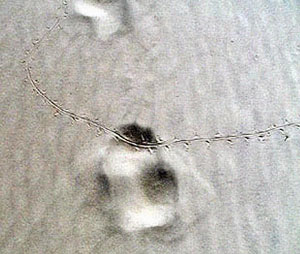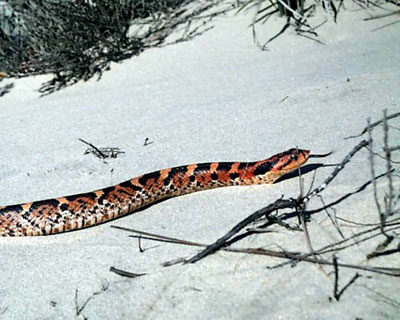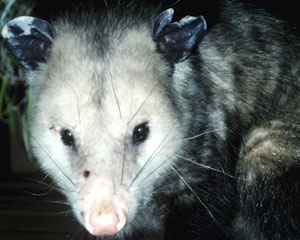Six-Lined Racerunner

The Six-Lined Racerunner is the fastest lizard in North America.
Raccoon

The Raccoon is a nocturnal (night-time) park visitor. A raccoon’s front paws are adapted to easily carry a variety of foods such as grapes, acorns, insects, frogs and crabs.

Hognose snake

The Hognose snake is a harmless reptile that leaves distinctive “S-shaped” tracks in the sand. The snake’s favorite food is toads, which it tracks with its sense of smell. The hognose uses some unique behaviors for defense such as hissing, flattening its neck, swelling with air and feigning death.
Rabbits

Rabbits can often be seen nibbling on the vegetation. They can usually can be seen at dusk and dawn.
![]()
Red Fox

Jockey’s Ridge is host to the Red Fox (shown here) and the Gray Fox. The fox feeds on anything, especially fruits and small mammals such as mice and rabbits. The persimmon trees are one of the important fruit sources for the fox in the fall. The grey fox is one of the few animals that walks in a straight line, very similar to a cat. The tracks shown are from a grey fox. This red fox was caught on camera by some park visitors.
![]()
Opposum

The Opposum is also a nocturnal animal and has a similar diet to the raccoon. They are the only North American marsupial which means they have a pouch to carry their young.

White-tailed Deer

The White-tailed Deer is a frequent visitor to the vegetated areas. The low trees and shrubs offer protection, resting areas, and food. Deer feed on wildflowers, acorns, and leaves. In their search for food, the deer travel back and forth between Jockey’s Ridge and Nags Head Woods.

Luna Moth

- Moths are nocturnal (active at night).
- Moth larvae love to eat hickory and walnut leaves.
- Male and female moths mate at night, for about four hours.
- The moth caterpillar changes its skin five times before it is fully grown.
- Adult Luna Moths have no mouth – they eat nothing.

